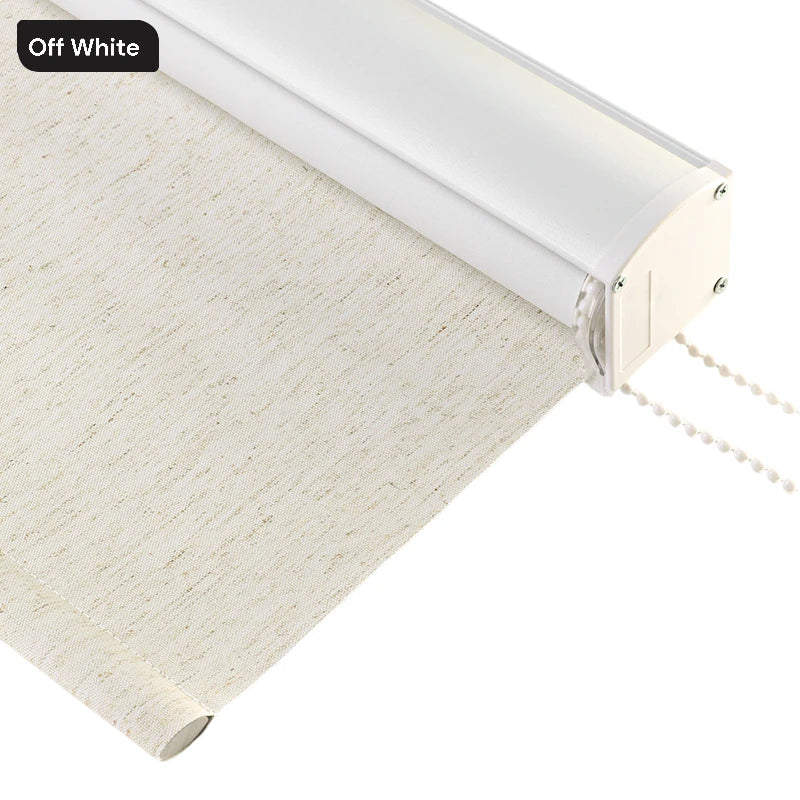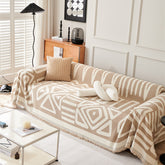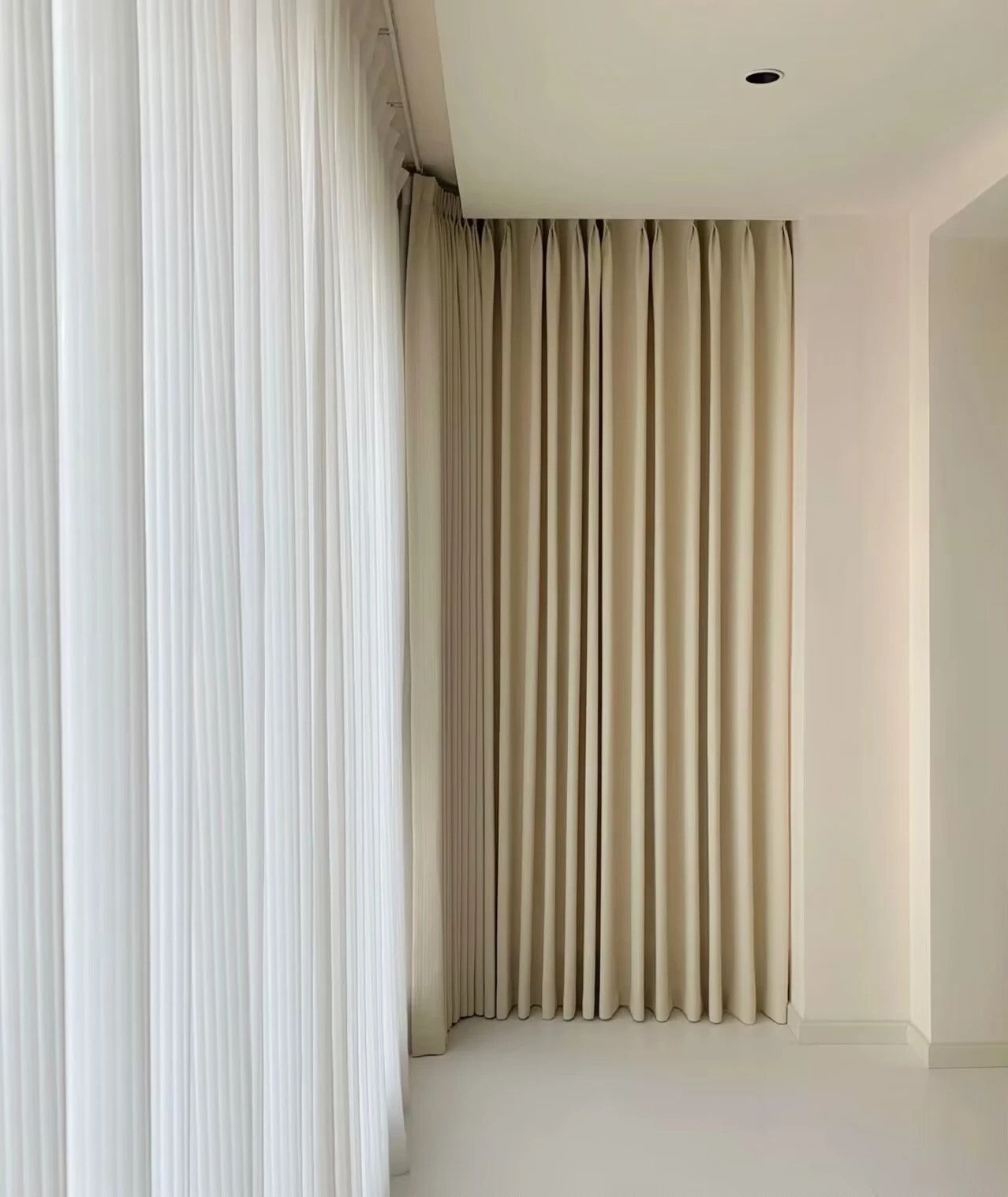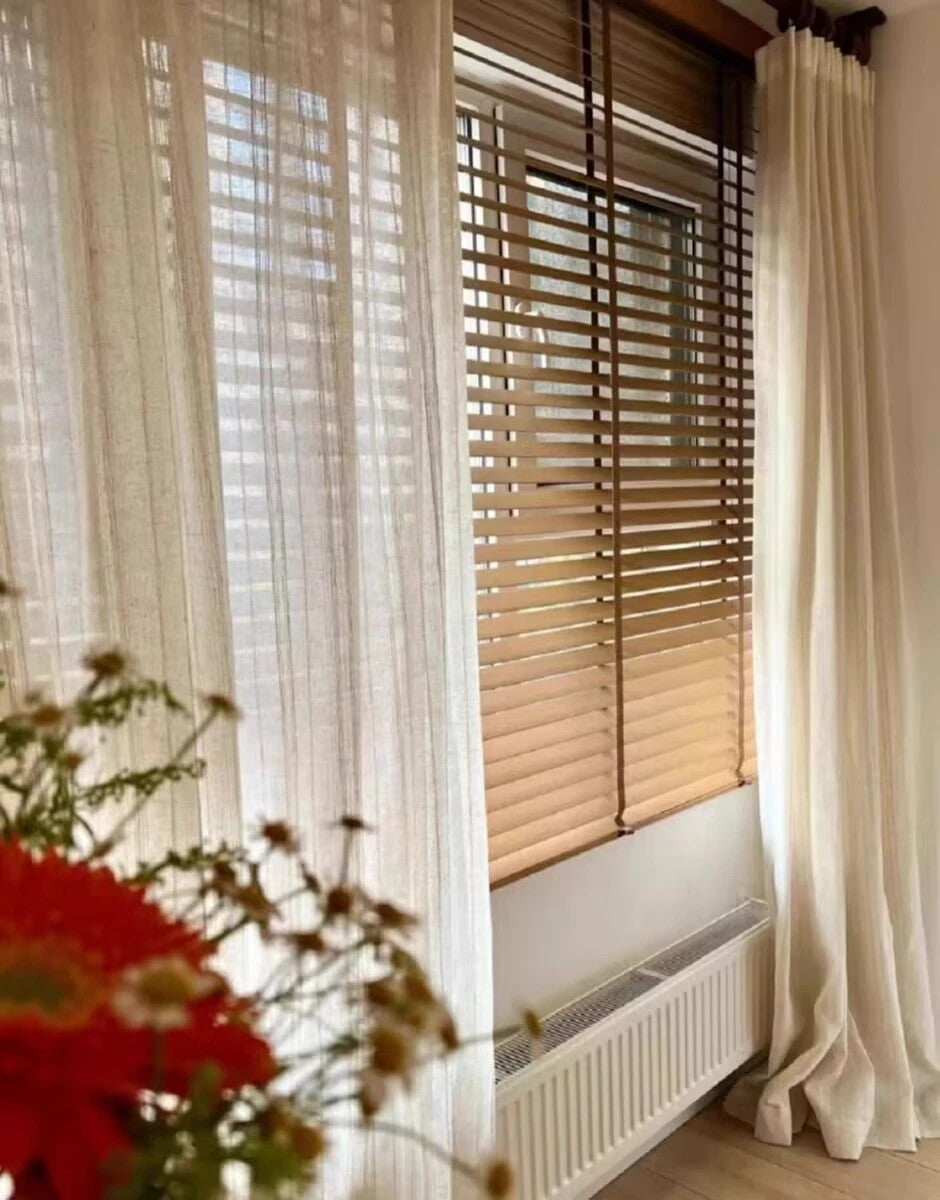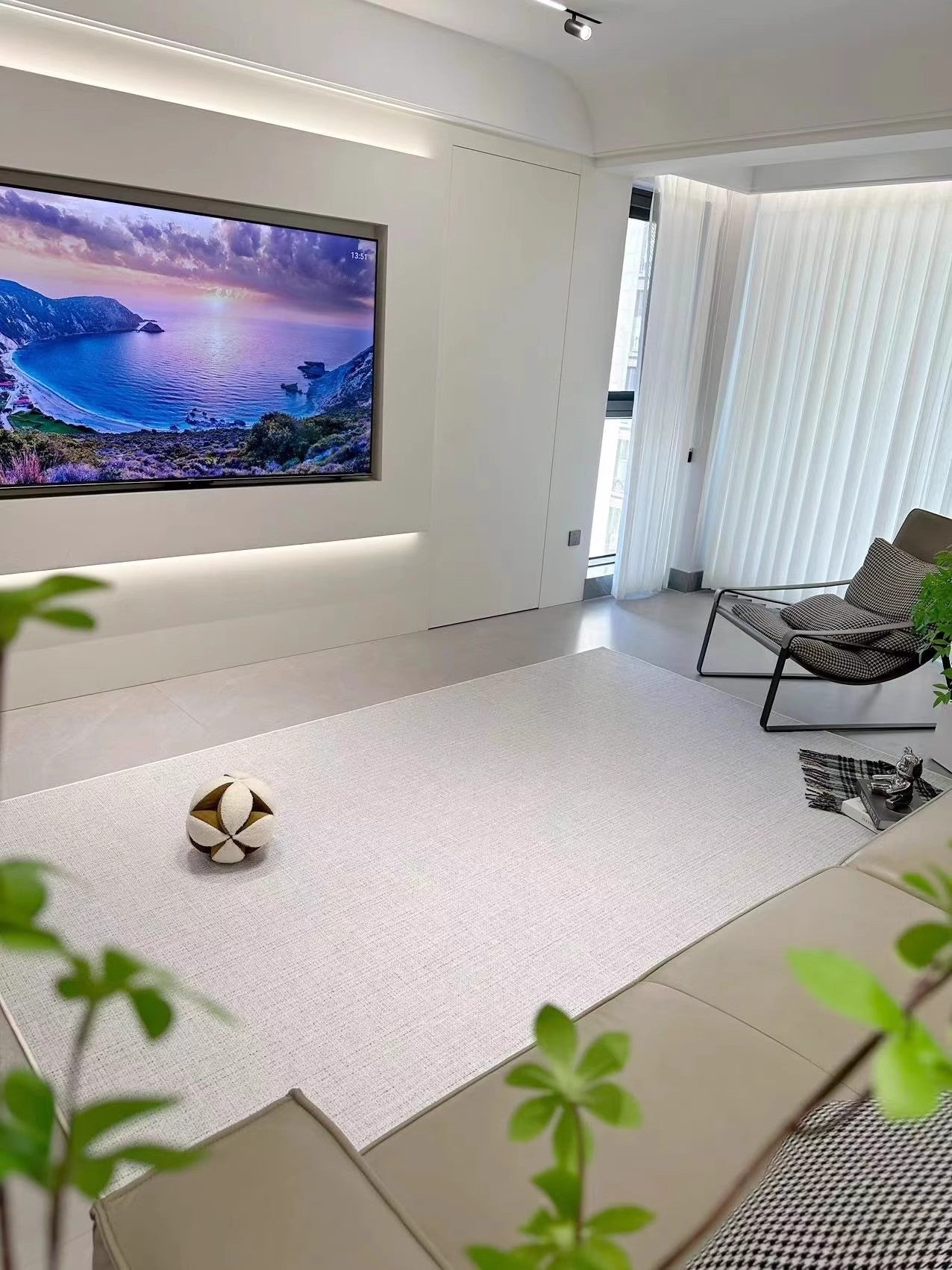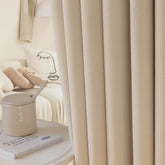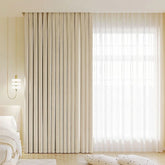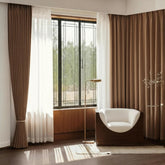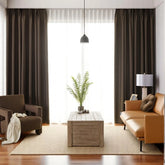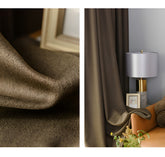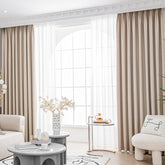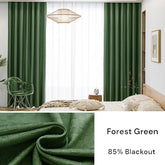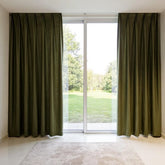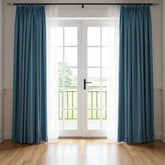¿Deben Coincidir Todas las Cortinas en una Habitación?
Hola, soy James, propietario de Dolcewe.com, y llevo más de una década en el negocio de las cortinas. Una pregunta que escucho a menudo es, ¿deben todas las cortinas de una habitación coincidir? Bueno, no es tan simple como un sí o no.
Hoy, compartiré algunos consejos internos para ayudarte a decidir si debes combinar o mezclar tus cortinas.
Con nuestras opciones de cortinas personalizadas desde solo $26.99, podrás crear el look perfecto para tu espacio, ¡sin importar lo que elijas!
Conclusiones clave:
| Sección principal | Conclusión clave |
|---|---|
| Cortinas a juego | Para un aspecto cohesivo, elige cortinas del mismo color o patrón para todas las ventanas. Para añadir profundidad, considera superponer cortinas con visillos o usar diferentes texturas dentro de la misma familia de colores. |
| Mezclando cortinas | Al mezclar cortinas, mantén una paleta de colores consistente y varía los patrones en escala. Por ejemplo, combina estampados florales grandes con diseños geométricos pequeños en colores complementarios. |
| Planos de planta abiertos | En espacios abiertos, usa cortinas a juego para crear continuidad visual. Opta por telas ligeras y translúcidas para mantener una sensación de ligereza mientras proporcionas privacidad. |
| Coordinando con los muebles | Elige cortinas que complementen, en lugar de coincidir exactamente, con tu sofá o alfombra. Escoge colores secundarios de tus muebles en la elección de tus cortinas para un aspecto armonioso. |
| Selección del color de las cortinas | Selecciona los colores de las cortinas según la función de la habitación. Tonos fríos como azul o verde promueven la relajación en dormitorios, mientras que tonos cálidos como amarillo o naranja energizan los espacios de estar. |
| Tamaño personalizado | Invierte en cortinas de tamaño personalizado para asegurar un ajuste perfecto en tus ventanas, mejorando tanto la estética como la funcionalidad. Esto elimina espacios y mejora el control de la luz y el aislamiento. |
Por qué las cortinas a juego en una habitación son lo mejor

Las cortinas a juego pueden ser un cambio radical para la decoración de tu hogar. Aquí está el porqué:
Crea un aspecto cohesivo
Las cortinas a juego unifican instantáneamente tu espacio, haciéndolo parecer más grande y ordenado.
Elige un color que complemente la pintura de tus paredes o la tapicería de tus muebles para un impacto máximo.
Simplifica la coordinación
Con cortinas a juego, es más fácil coordinar otros elementos en tu habitación.
Por ejemplo, si tienes cortinas azul marino, considera agregar cojines o una alfombra con acentos azul marino para unificar la habitación.
Mejora la luz natural
Las cortinas uniformes pueden ayudar a controlar la luz de manera consistente en todas las ventanas.
Opta por telas que filtren la luz en colores a juego para crear un brillo suave y uniforme en toda la habitación.
Maximiza espacios pequeños
En habitaciones pequeñas, las cortinas a juego crean la ilusión de más espacio. Elige cortinas que se mezclen con el color de la pared para que la habitación parezca más grande.
Aquí es cuando las cortinas a juego funcionan mejor:
| Tipo de habitación | Por qué Funciona Combinar |
|---|---|
| Dormitorios | Crea un espacio tranquilo y relajante |
| Salas formales | Se ve ordenado y planificado |
| Comedores | Añade un toque de clase |
| Espacios pequeños | Hace que la habitación se sienta más grande |
Consejos para Combinar Cortinas con Éxito

-
Mide con Precisión: Asegúrate de que todas las cortinas tengan la misma longitud para un aspecto pulido. Consulta nuestra calculadora de tamaño de cortinas para ayuda. Nuestro tamaño personalizado comienza desde solo $26.99.
-
Considera la Textura: Incluso con colores a juego, varía las texturas para mayor interés. Combina paneles transparentes con cortinas más pesadas del mismo tono.
-
Usa Patrones Estratégicamente: Si usas cortinas con patrones, mantén los otros elementos de la habitación simples para evitar el desorden visual.
-
Capas con Persianas: Combina cortinas a juego con persianas neutras para opciones versátiles de control de luz y privacidad.
Recuerda, aunque combinar cortinas suele ser ideal, hay formas de mezclar y combinar con éxito.
Si te sientes aventurero, prueba a coordinar diferentes patrones dentro de la misma familia de colores o usa un elemento unificador como ribetes o ataduras a juego.
En Dolcewe.com, ofrecemos una amplia gama de opciones personalizables para ayudarte a lograr el aspecto perfecto para tu espacio. Ya sea que estés combinando o mezclando, ¡estamos aquí para ayudarte a que tus ventanas brillen!
Reglas Simples de Color para Tus Cortinas

El color de la pared es lo primero en lo que debes pensar. Tus cortinas colgarán contra tus paredes. Deben verse bien juntas.
Para paredes blancas o beige, puedes elegir cualquier color de cortina que te guste. Estos colores de pared combinan con todo. Esto te da más opciones.
Si tienes paredes audaces como azul o verde, prueba estas opciones:
- Combina tus cortinas con el color de tus paredes
- Elige cortinas en un color que combine bien con el color de tus paredes
- Elige cortinas blancas o crema para un aspecto limpio
El uso de la habitación también importa. Los dormitorios necesitan cortinas que bloqueen la luz para un buen descanso. Las salas pueden necesitar cortinas más ligeras para una sensación luminosa.
Diferentes Maneras de Mezclar y Combinar Cortinas en una Habitación

Mientras que combinar cortinas es sencillo, mezclar y combinar puede crear un espacio más dinámico y personalizado.
Aquí tienes algunas técnicas prácticas para ayudarte a mezclar cortinas de manera efectiva:
1. Mezclando Diferentes Estilos de Cortinas
Pasos a Seguir:
- Compra nuestro double rod track y combina cortinas transparentes con cortinas más pesadas para un look en capas
- Usa cortinas tipo café en ventanas bajas y cortinas de largo completo en las más grandes
- Combina persianas romanas con paneles laterales para una apariencia sofisticada
Asegúrate siempre de que los acabados de la barra de la cortina coincidan para mantener la cohesión.
2. Armonizando Patrones de Cortinas
Guía para Mezclar Patrones:
| Patrón Principal | Patrón complementario |
|---|---|
| Floral grande | Geométrico pequeño |
| Rayas audaces | Textura sutil |
| Chevron | Color sólido |
Elige un patrón dominante y usa el otro como acento en el 25% de las ventanas.
3. Equilibrando los colores de las cortinas
Estrategias para mezclar colores:
- Usa la regla 60-30-10: 60% color dominante, 30% color secundario, 10% color de acento
- Elige cortinas en diferentes tonos de la misma familia de colores
- Selecciona colores de lados opuestos de la rueda de colores para un contraste audaz
Prueba tus combinaciones de colores con las muestras de tela de Dolcewe.com antes de comprar.
4. Creando flujo visual
Sugerencias prácticas:
- Usa el mismo estilo de cortina pero en colores graduados a lo largo de la habitación
- Alterna cortinas lisas y con estampados en ventanas adyacentes
- Unifica diferentes estilos de cortinas con sujetadores o cenefas a juego
Recuerda: El objetivo es crear un aspecto cohesivo que realce el diseño general de tu habitación.
No temas experimentar, y siempre considera el tamaño de la habitación, la luz natural y la decoración existente al mezclar cortinas.

Considerando situaciones únicas de combinación

Aunque combinar cortinas a menudo crea un aspecto cohesivo, algunas situaciones requieren un enfoque más flexible.
Aquí hay soluciones prácticas para desafíos comunes:
Planos de planta abiertos
Combina cortinas en todo el espacio para una apariencia unificada.
Consejos prácticos:
- Elige un solo color o patrón para todas las cortinas
- Usa el mismo peso y textura de tela en todas las ventanas
- Mantén longitudes de cortinas consistentes en todo el espacio
Diferentes formas de ventanas
Coordina cortinas enmarcando paredes específicas de manera consistente.
Consejos prácticos:
- Combina cortinas en la misma pared, incluso si las formas de las ventanas difieren
- Usa el mismo color pero varía los estilos para ventanas con formas únicas
- Mantén longitudes de cortinas consistentes en cada pared
Coordinando con elementos de la habitación
Concéntrate en una paleta de colores cohesiva en lugar de coincidencias exactas.
Consejos prácticos:
- Elige cortinas que complementen tus piezas principales de mobiliario
- Usa colores de cortinas que aparezcan en las obras de arte o accesorios de tu habitación
- Selecciona cortinas en tonos variados del color dominante de tu habitación
Estrategias de coordinación de colores
Al tratar con cortinas de diferentes colores, usa estas técnicas:
- Colores complementarios: elige cortinas en colores que están opuestos en la rueda de colores (por ejemplo, azul y naranja)
- Colores análogos: selecciona cortinas en colores que están uno al lado del otro en la rueda de colores (por ejemplo, azul y verde)
- Esquema monocromático: usa diferentes tonos del mismo color para un aspecto sutil y cohesivo
Tabla de referencia rápida: soluciones para combinar cortinas
| Situación | Solución | Ejemplo |
|---|---|---|
| Plano abierto | Cortinas uniformes | Cortinas de lino completamente blancas |
| Tamaños de ventana mixtos | Color consistente, estilos variados | Persianas romanas navy y cortinas navy |
| Decoración ecléctica | Paleta de colores coordinada | Cortinas en tonos de azul, verde y teal |
Recuerda, en Dolcewe.com ofrecemos cortinas de tamaño personalizado desde $26.99, permitiéndote lograr un ajuste perfecto y un look coordinado para cualquier disposición de ventanas en tu hogar.
¿Deben combinar las cortinas en un plano abierto?

Cuando se trata de cortinas en planos abiertos, combinar suele ser la mejor opción.
Aquí te explicamos por qué y cómo hacerlo efectivamente:
Beneficios de combinar cortinas
- Crea armonía visual
- Proporciona un fondo consistente
- Mejora el esquema general de diseño
Cómo combinar cortinas en planos abiertos
- Elige cortinas ligeras y translúcidas: Estas crean una sensación de ligereza y permiten la luz natural mientras mantienen la privacidad.
- Opta por colores neutros: Blancos, beige o grises claros funcionan bien en la mayoría de los espacios.
- Mantén la longitud consistente: Asegúrate de que todas las cortinas lleguen al mismo punto, preferiblemente tocando el suelo.
Consejos para combinar cortinas desiguales (si lo deseas)
Si prefieres algo de variedad, sigue estas pautas:
- Mantente en una temática de color: Usa diferentes tonos de la misma familia de colores.
- Mantén la tela consistente: Usa el mismo material para todas las cortinas, incluso si los patrones son diferentes.
- Equilibra los patrones: Si usas cortinas con patrones, alterna con colores sólidos para evitar saturar el espacio.
Sugerencias prácticas para clientes de Dolcewe.com
- Mide con precisión: Usa nuestras opciones de tamaño personalizado para asegurar un ajuste perfecto en todas las ventanas.
- Prueba antes de comprar: Pide muestras de tela para probar en tu espacio antes de decidirte.
- Considera el control de luz: Elige entre nuestra gama de opciones desde filtrado de luz hasta blackout según tus necesidades.
Guía de selección de cortinas para planos abiertos
| Factor | Cortinas a juego | Cortinas desparejadas |
|---|---|---|
| Efecto visual | Cohesivo, unificado | Variado, dinámico |
| Facilidad de selección | Más simple | Más complejo |
| Versatilidad | Funciona en la mayoría de los espacios | Requiere planificación cuidadosa |
| Mejor para | Áreas grandes y abiertas | Definiendo zonas separadas |
Recuerda, ya sea que elijas cortinas a juego o desparejadas, la clave es crear un espacio visualmente agradable y cohesivo que refleje tu estilo personal.
En Dolcewe.com, ofrecemos una amplia gama de opciones personalizadas desde solo $26.99 para ayudarte a lograr el aspecto perfecto para tu plano abierto.
Cambiar cortinas con las estaciones

Puedes cambiar tus cortinas cuando cambian las estaciones. Esto actualiza tu hogar sin comprar muebles nuevos.
Primavera y verano requieren cortinas ligeras y aireadas. Los colores claros y las telas delgadas dejan entrar más sol. Esto hace que tu hogar se sienta fresco y agradable.
Otoño e invierno son perfectos para cortinas opacas más gruesas. Las telas más pesadas ayudan a mantener el calor dentro. Los colores oscuros se sienten acogedores cuando hace frío afuera.
Puedes tener dos juegos de cortinas para cambiar durante el año. Esto funciona mejor con ventanas estándar. Pero podemos hacer cortinas personalizadas para cualquier estación
¿Deben las cortinas combinar con el sofá o la alfombra?

Al elegir cortinas, es crucial considerar cómo se coordinarán con tus muebles existentes.
Aquí tienes algunos consejos prácticos para ayudarte a tomar la decisión correcta:
Combinar cortinas con sofá y Carpet
Cuándo hacerlo:
- En espacios grandes y abiertos
- Para crear un aspecto cohesivo y lujoso
- Cuando trabajes con un esquema de color específico
Cómo hacerlo:
- Elige cortinas en un color que complemente tanto tu sofá como la alfombra
- Usa una rueda de colores para encontrar tonos armoniosos
- Considera la textura para añadir profundidad (por ejemplo, cortinas de terciopelo con una alfombra mullida)
Combinar cortinas con ventanas
Cuándo hacerlo:
- En habitaciones pequeñas para crear una ilusión de espacio
- Para resaltar hermosos marcos de ventana o vistas
- Cuando quieres un esquema de decoración más versátil
Cómo hacerlo:
- Selecciona cortinas que coincidan o complementen el color del marco de la ventana
- Opta por telas ligeras y aireadas para maximizar la luz natural
- Usa barras para cortinas que se extiendan más allá del marco de la ventana para que las ventanas parezcan más grandes
Guía rápida para decidir
| Tu objetivo | Enfoque recomendado |
|---|---|
| Crea un aspecto unificado | Combina las cortinas con el sofá y la alfombra |
| Haz que una habitación parezca más grande | Coordina las cortinas con las ventanas |
| Destaca un sofá llamativo | Elige cortinas neutrales |
| Agrega color a una habitación neutral | Selecciona cortinas audaces y contrastantes |
Recuerda, en Dolcewe.com, ofrecemos cortinas a medida desde solo $26.99, permitiéndote encontrar la combinación perfecta para tu espacio único. ¡Ya sea que busques cohesión o contraste, te tenemos cubierto!
Elegir el color perfecto para las cortinas: una guía para cada habitación
Seleccionar el color adecuado para las cortinas puede transformar tu espacio. Aquí te mostramos cómo hacer la mejor elección para tu hogar:
Combina con tu decoración existente
Para un aspecto cohesivo, elige cortinas que complementen tus muebles actuales:
- Color del sofá: Si tienes un sofá azul marino, opta por cortinas en un tono similar o un color complementario como gris claro o crema.
- Papel tapiz: Combina tus cortinas con un color secundario del patrón de tu papel tapiz para un efecto armonioso.
- Alfombrado: Elige cortinas que sean un tono más claro o más oscuro que tu alfombra para un aspecto equilibrado.
Realza el tema de tu habitación
Si tienes un tema específico, selecciona cortinas que lo refuercen:
| Tema de la habitación | Colores de cortinas recomendados |
|---|---|
| Playa | Tonos de azul, blanco o beige arenoso |
| Moderno | Blanco nítido, gris carbón o negro |
| Rústico | Tonos tierra como verde oliva o marrón cálido |
| Romántico | Pasteles suaves o tonos joya intensos |
Crea el ambiente adecuado
Usa los colores de las cortinas para influir en la atmósfera de tu habitación:
- Brillante y aireado: Elige colores claros como blanco, crema o amarillo pálido.
- Acogedor e íntimo: Opta por tonos más oscuros como azul profundo, verde bosque o burdeos.
- Calma y serenidad: Selecciona tonos suaves y fríos como azul claro, verde salvia o lavanda.
Coordina múltiples ventanas
Para habitaciones con varias ventanas, asegura un aspecto unificado:
- Usa el mismo color para todas las cortinas.
- Elige colores complementarios dentro de la misma paleta.
- Alterna entre cortinas lisas y con patrones en colores coordinados.
Consejo profesional: Considera la exposición a la luz
- Habitaciones orientadas al norte: Elige colores cálidos para contrarrestar la luz fría.
- Habitaciones orientadas al sur: Opta por tonos fríos para equilibrar la luz solar brillante.
- Habitaciones orientadas al este o al oeste: Selecciona colores neutros que funcionen bien tanto con la luz de la mañana como de la tarde.
Recuerda, el color perfecto de cortina debe reflejar tu estilo personal mientras realza el diseño general de tu habitación. En Dolcewe.com, ofrecemos cortinas de tamaño personalizado en una amplia gama de colores desde solo $26.99, asegurando que encuentres la combinación ideal para tu espacio.
Tomando la decisión correcta de cortinas personalizadas para tu habitación en Dolcewe
Al decidir las cortinas para tu habitación, considera estos puntos clave:
A juego vs. Mezcla: Una guía rápida
| Escenario | Recomendación |
|---|---|
| Planos de planta abiertos | Usa cortinas a juego para un aspecto unificado |
| Diferentes formas de ventanas | Coordine colores o patrones en lugar de coincidencias exactas |
| Paredes de acento | Elija cortinas que complementen el color de acento |
| Múltiples esquemas de color | Seleccione un color de cortina neutro que funcione con todos los esquemas |
Consejos prácticos para la coordinación de cortinas
- Consistencia de color: Elija cortinas en la misma familia de colores que sus paredes para un aspecto cohesivo.
- Juego de patrones: Si mezcla patrones, mantenga la paleta de colores consistente y varíe la escala de los patrones.
- Mezcla de texturas: Combine diferentes texturas (por ejemplo, telas transparentes y pesadas) para interés visual manteniendo la armonía de color.
- Punto focal: Use un patrón de cortina audaz en una ventana como punto focal, con colores sólidos coordinados en las otras ventanas.
Soluciones personalizadas de Dolcewe
En Dolcewe, ofrecemos:
- Tamaños personalizados desde $26.99
- Una amplia gama de colores, telas y patrones
- Consejos expertos sobre la coordinación de cortinas
Pida muestras de tela de Dolcewe para probar diferentes opciones en su espacio antes de tomar una decisión final.
Preguntas frecuentes
¿Deben coincidir todas las cortinas en una habitación?
Aunque generalmente se recomienda que las cortinas en una habitación sean a juego para un aspecto cohesivo, hay casos en los que mezclar cortinas puede hacerse con éxito. Sin embargo, se debe tener precaución para asegurar que los diferentes patrones o colores de las cortinas estén equilibrados y coordinados de manera que realcen la estética general de la habitación.
¿Por qué es mejor que las cortinas en una habitación sean a juego?
Las cortinas a juego ayudan a crear un aspecto cohesivo y visualmente agradable. Garantizan un cierto nivel de uniformidad y crean una apariencia limpia y nítida. Las cortinas desparejadas, si no se hacen con cuidado, pueden resultar en un efecto visual discordante y romper la armonía de la habitación.
¿Cuáles son las diferentes formas de mezclar y combinar cortinas en una habitación?
Un enfoque es usar dos patrones o colores diferentes de cortinas de manera uniforme en todo el espacio. Otra opción es usar cortinas más pesadas en ventanas que requieran más privacidad o control de luz, mientras se usan cortinas más ligeras en otras ventanas. Además, las cortinas pueden mezclarse usando el mismo patrón pero diferentes tipos de tratamientos, o haciendo una transición gradual de un patrón a un aspecto más monocromático. Alternar patrones y colores también puede usarse para crear una estética equilibrada y unificada.
¿Existen situaciones únicas a considerar al combinar cortinas?
Factores como la presencia de un plano abierto, diferentes formas de ventanas o la necesidad de combinar las cortinas con otros elementos en la habitación pueden requerir un enfoque más flexible. En tales casos, es importante considerar factores como mantener una fachada consistente, enmarcar paredes específicas con cortinas o mantener una paleta de colores coordinada.
¿Deben las cortinas combinar en un plano abierto?
En la mayoría de los casos, es aconsejable combinar las cortinas en un plano abierto para crear una sensación de uniformidad y coordinación en un espacio visualmente conectado. Las cortinas ligeras y translúcidas suelen ser preferidas en planos abiertos para crear una sensación amplia y aireada. Sin embargo, si se opta por cortinas desparejadas, es esencial mantener un aspecto monocromático o adherirse a un tema específico para mantener la armonía visual.
¿Deben las cortinas combinar con el sofá o la alfombra?
Si las cortinas deben combinar con el sofá o la alfombra es subjetivo y depende de la preferencia personal y la estética deseada. Algunas personas prefieren coordinar las cortinas con ambos, el sofá y la alfombra, para crear un aspecto cohesivo y coordinado. Otros pueden elegir combinar las cortinas más cerca de las ventanas que están cubriendo, especialmente en habitaciones pequeñas.
¿Qué color de cortinas deberías elegir?
No existe una regla estricta para elegir el color ideal de las cortinas. Generalmente se recomienda combinar las cortinas con el sofá, el papel tapiz o la alfombra de la habitación para crear una sensación de armonía y cohesión. Sin embargo, si hay un tema de color específico en la habitación, combinar las cortinas con ese tema también puede ser una elección inteligente. Alternativamente, se pueden elegir colores neutros como blanco o crema para asegurar que las cortinas complementen el diseño general sin opacarlo.
¿Cuáles son los consejos generales para combinar cortinas?
Cuando se trata de combinar cortinas, el consenso general es optar por un aspecto cohesivo y coordinado para crear una apariencia unificada y bien arreglada en una habitación. Sin embargo, hay ocasiones en las que mezclar y combinar cortinas puede hacerse con éxito. La clave es tener un ojo agudo para el diseño, el equilibrio y la coordinación. Ya sea combinando o mezclando, es importante asegurarse de que las cortinas realcen la estética general del espacio.



